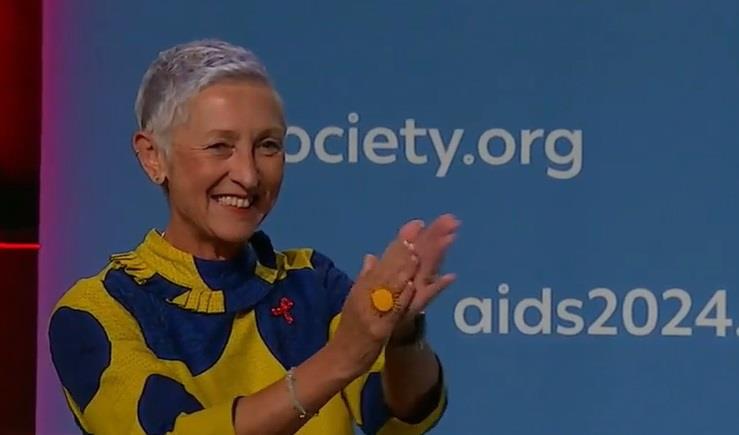Zero HIV infections: Lenacapavir fulfils PURPOSE in cis women





In the interim analysis of the pivotal phase III PURPOSE 1 trial, twice-yearly subcutaneous lenacapavir, a first-in-class, high-potency HIV-1 capsid inhibitor, shows 100-percent efficacy and superiority to background HIV (bHIV*) incidence and daily oral emtricitabine/tenofovir disoproxil fumarate (F/TDF**) for pre-exposure prophylaxis (PrEP) in HIV-negative cisgender women.
“Despite PrEP’s promise, many young women have found uptake, daily adherence, and persistence to daily PrEP a social, emotional, and physical challenge. For them, we need new and diverse PrEP options,” said Professor Linda-Gail Bekker from The Desmond Tutu HIV Centre, University of Cape Town in South Africa, at AIDS 2024.
“I am delighted to show the results of PURPOSE 1. A total of 55 incident HIV infections were observed during almost 5,000 person-years (PY) of follow-up. Zero occurred in the lenacapavir group,” shared Bekker, amidst a roaring applause during her presentation. “[This means that] lenacapavir prevented 100 percent of women from acquiring HIV.”
Of the 55 incident cases, 39 occurred with F/TAF*** (2.02 cases/100 PY), while the remaining 16 were observed with F/TDF (1.69 cases/100 PY). In the bHIV group, HIV incidence per 100 PY was 2.41 cases. Lenacapavir reduced HIV incidence by 100 percent vs bHIV and F/TDF (p<0.0001 for both). [AIDS 2024, abstract SS0407]
Treatment adherence, safety
PrEP adherence in cisgender women remains suboptimal worldwide. [AIDS Care 2021;33:712-720; AIDS Behav 2023;27:279-289] In PURPOSE 1, on-time adherence with lenacapavir was high (>90 percent at weeks 26 and 52). Disappointingly, adherence was poor with oral F/TAF and F/TDF, with adherence waning over time.
Bekker underlined that HIV protection was strongly associated with F/TAF adherence, as evidenced by the lower likelihood of HIV infection with medium/high vs low F/TAF adherence in a matched case-control analysis (odds ratio, 0.11 p=0.0006).
Grade ≥3 adverse events (AEs) with lenacapavir were uncommon (4.1 percent), as were serious AEs (2.8 percent) and AEs leading to drug discontinuation (0.2 percent). The most common AEs associated with lenacapavir were urinary tract infection, genitourinary chlamydia infection, and headache (14.4, 14, and 13.3 percent, respectively). The AEs align with those reported in other trials. [Lancet HIV 2023;10:e15-e23; Lancet HIV 2023;10:e497-e505]
“Lenacapavir is injected into the subcutaneous space and forms a drug depot ... As the drug elutes over time, the depot gets smaller, and the nodules resolve or reduce in size substantially prior to the next injection,” explained Bekker. In the study, only four injection site reactions from >25,000 injections led to discontinuation.
Effect in pregnant women
Of the 193 confirmed pregnancies in the lenacapavir arm, 105 (54.4 percent) were completed pregnancies. Fifty-five led to births (ie, completed uninterrupted pregnancies that include live and still births).
According to Bekker, the inclusion of pregnant and lactating women, their offspring, and adolescents for the first time in an adult pivotal PrEP trial is one of the groundbreaking features of the study. “This is beyond wonderful and sets a new benchmark for the conduct of these studies.”
A vital new tool against HIV
The first phase III HIV prevention trial to show zero infections, PURPOSE 1 evaluated 5,338 sexually active, cisgender women and adolescent girls (median age 21 years) from South Africa and Uganda. They were not on PrEP, nor had they tested for HIV in the preceding 3 months.
Participants were randomized 2:2:1 to lenacapavir Q6M, F/TAF daily, or F/TDF daily (secondary comparator or active control) with corresponding placebo. The primary comparator was bHIV. Lenacapavir was administered subcutaneously as two 1.5-mL injections after a loading dose of two lenacapavir pills on days 1 and 2.
In light of the independent data monitoring committee’s recommendation to stop the blinded phase of the trial, open-label lenacapavir was offered to all participants.
“With zero infections and 100-percent efficacy, twice-yearly lenacapavir has demonstrated its potential as an important new tool to help prevent HIV infections,” noted Dr Merdad Parsey, Chief Medical Officer, Gilead Sciences, in another news release.
The PURPOSE programme
“We look forward to additional results from the ongoing PURPOSE clinical programme and continuing toward our goal of helping to end the HIV epidemic for everyone, everywhere,” Parsey said.
The programme includes five HIV prevention studies. The results of PURPOSE 2# are anticipated in late 2024 or early 2025. Filing for regulatory approval will encompass PURPOSE 1 and 2 results in hopes of gaining approval for populations who are most disproportionately affected by HIV.
Global goal to end HIV
“Twice-yearly lenacapavir for PrEP, if approved, could provide a critical new choice for HIV prevention that fits into the lives of many people who could benefit from PrEP around the world – especially cisgender women,” noted Bekker in the news release.
The long half-life of lenacapavir allows for the 6-monthly dosing, noted Bekker. “While we know traditional HIV prevention options are highly effective when taken as prescribed, twice-yearly lenacapavir for PrEP could help address the stigma and discrimination some people may face when taking or storing oral PrEP pills, as well as potentially help increase PrEP adherence and persistence given its twice-yearly dosing schedule.”
“[In sum,] twice-yearly lenacapavir offers an efficacious, safe, and discreet choice to improve PrEP use among cisgender women,” Bekker concluded. “A twice-yearly PrEP choice could overcome some of the adherence and persistence challenges and contribute critically to our quest to reduce HIV infection in women around the world.”
 Professor Linda-Gail Bekker closes her presentation at AIDS 2024 with a standing ovation.
Professor Linda-Gail Bekker closes her presentation at AIDS 2024 with a standing ovation.